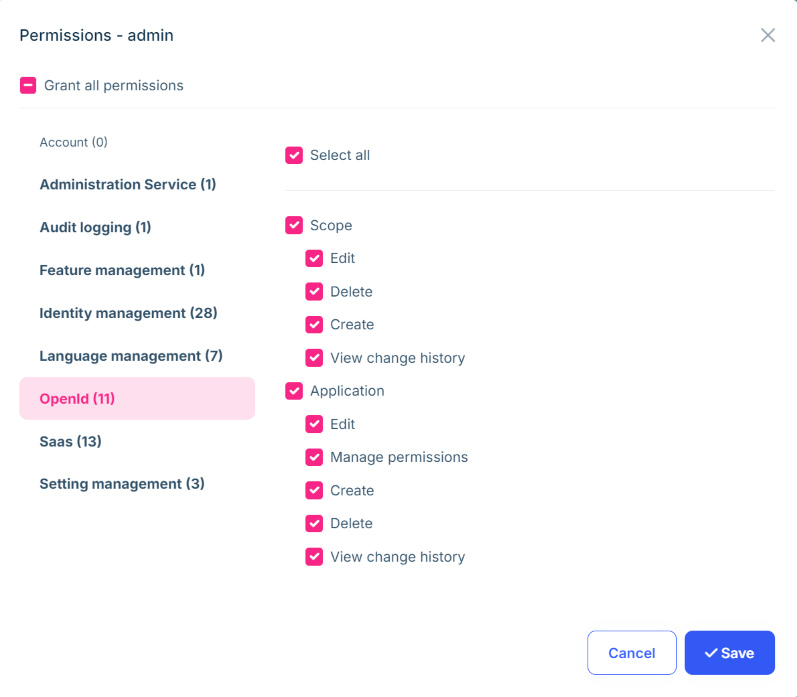Microservice Solution: Permission Management
You must have an ABP Business or a higher license to be able to create a microservice solution.
The Administration microservice is responsible for managing permissions. It is used by all the services and applications in the solution. This document explains how permission management works in the microservice solution.
When we send a request to /api/abp/application-configuration, the gateway application forwards the request to the Administration microservice. The Administration microservice returns the application configuration, which includes the granted policies (permissions) for the current user. You can see the details of the application configuration here: Application Configuration.
Since Permission Management is a fundamental feature module, each microservice depends on the Volo.Abp.PermissionManagement.EntityFrameworkCore (or Volo.Abp.PermissionManagement.MongoDB) package. These modules provide the necessary infrastructure (such as IPermissionStore) to check permissions. Additionally, the Administration microservice depends on the Volo.Abp.PermissionManagement.Application, Volo.Abp.PermissionManagement.HttpApi, Volo.Abp.PermissionManagement.Domain.OpenIddict, and Volo.Abp.PermissionManagement.Domain.Identity packages to manage (grant or revoke) permissions.
Permission Management
The Administration microservice provides a set of APIs to manage permissions. Every microservice defines its own permissions. When a microservice starts, it registers its permissions to the related permission definition tables if SaveStaticPermissionsToDatabase option is true for PermissionManagementOptions. Since the default value is true, this behavior is ensured. After that, you can see the permissions from the Permission Management Dialog for related provider such as User, Role or Client (OpenIddict Applications).

When you define a new permission to a microservice, you need to restart the related microservice to register the new permission to the permission definition tables. However, after the permission definition is registered, the admin role does not have the permission by default. This is because only the Administration microservice tries to seed the permissions to the admin role. So, new permissions are not granted to the admin role automatically. You need to grant the new permissions to the admin role manually, or when the Administration service is restarted, it will grant the new permissions to the admin role automatically.
If you want to grant the new permissions to the admin role automatically, you can create a data seeder and use the
IPermissionDataSeederservice. For example, the Identity microservice uses this approach because when the first admin user logs in, they should be able to edit users and roles. You can see the details in theIdentityServiceDataSeederclass in the Identity microservice.
Administration Service Permission Management Option
SaveStaticPermissionsToDatabase default value is true and it is used to save the static permissions to the database. Each microservice already adds their permission definitions to the related table. However, there is also another option IsDynamicPermissionStoreEnabled, which is used to enable the dynamic permission store. We need to enable this option only for the Administration microservice, because the Administration microservice is the only service that manages the permissions. All other services and applications use their own permission definitions and do not need to know others' permissions.
You can see this option in the ConfigurePermissionManagement method of the Administration microservice module:
private void ConfigurePermissionManagement()
{
Configure<PermissionManagementOptions>(options =>
{
options.IsDynamicPermissionStoreEnabled = true;
});
}
Creating a New Permission
You can define new permissions in the MicroservicenamePermissionDefinitionProvider in the Contracts project for the related microservice. For example, the Identity microservice has a IdentityServicePermissionDefinitionProvider class. You can see the details in the Identity microservice.
public class IdentityServicePermissionDefinitionProvider : PermissionDefinitionProvider
{
public override void Define(IPermissionDefinitionContext context)
{
//var myGroup = context.AddGroup(IdentityServicePermissions.GroupName);
}
private static LocalizableString L(string name)
{
return LocalizableString.Create<IdentityServiceResource>(name);
}
}
Since identity related permissions comes from Identity module, there is no need to define new permissions. However, you can add new permissions to the Identity microservice if you need.


























































